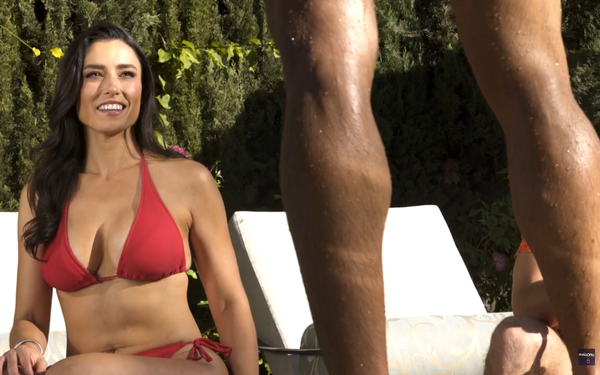health
Penile Girth Enlargement Makes TV Ad Debut New Year's Day
- by Les Luchter , December 26, 2023

Scene: poolside.
A busty, bikinied woman walks by two staring men and sits on a lounger next to them.
A third man gets out of the pool as the woman stares in happy amazement at his pelvis, which goes unseen by viewers.
Man #2: “I thought the water was cold.”
Man # 3 walks away and winks at camera.
Voiceover: “Be the man you were meant to be. PhalloFill.com.”
PhalloFill hopes men will get the implied message from the above commercial -- namely, that they, too, can get a bigger penis through treatment.
The:30 spot, created by Straw Hat Productions, is presumed to be the first-ever commercial for a penis enlargement procedure, medically known as penile girth enlargement.
advertisement
advertisement
The PhalloFill procedure is done through off-label use of Hyaluronic Acid Dermal Filler, which has only been approved by the FDA for use in such locations as lips and wrinkles.
PhalloFill’s website points out that this dermal filler “has been proven safe and effective for volume improvement since the first FDA clearances in 2004.”
Results are touted as “semi-permanent,” though "follow-up" treatments "may be necessary every 12 to 18 months."
PhalloPhill founder William Moore tells Marketing Daily that on-label approval for his procedure is at least a year to two away, primarily because of a $15 million application fee.
Back to the ad: Debuting New Year’s Day in the Dallas, Philadelphia, Miami and Los Angeles markets and scheduled for an initial three-month run, the ad will target 30- to 55-year-old men via a mix of channels. Those initially include ESPN and Fox News, says Moore, who also plans to “dabble with a home improvement station and maybe a golf station.”
The channel mix, bought through Charter’s Spectrum Reach, will be adjusted after two months, based on initial results, Moore says. But that won’t happen till April, since he plans to spend the entire ad budget in March on March Madness sports channels.
Media includes both cable and streaming, with the commercial also being done in a :60 version for social media and in a shorter version for YouTube and other internet platforms.
The four markets were chosen because they’re among PhalloFill’s busiest, Moore says. Just a couple of years since launch, the company now boasts 20 providers in 17 markets, all of whom are trained personally by Moore. His plan is to “eventually” roll out the campaign to all PhalloFill markets.
The campaign aims to increase awareness of penis enlargement in general -- and to “make male enhancement as normal as breast augmentation for women," says Moore. That’s why “we use the girl with the large breasts and the guys looking at the breasts.”
The commercial is deliberately vague for a couple of reasons, he adds. One was “to make sure we didn’t get any rejections from any markets.”
That effort still fell short, as the spot was rejected last week by CNN and TBS, because of their policies not to advertise male enhancement products, according to a PhalloFill representative.
The other reason for the vagueness is to capture viewers’ attention.
“It’s just intriguing enough to make one go to the website to see what PhalloFill is, especially when they’ve just seen the look on those guys’ faces and the girl’s face," Moore notes.
Moore says he was initially surprised that -- for a procedure costing thousands of dollars (up to $10,000) -- PhalloFill customers in his Dallas base were largely blue-collar workers.
“Men who have money with a small penis buy a car,” he jokes, “Guys who have less money with a small penis buy a bigger penis.”
Jokes aside, Moore says that about 40% of his PhalloFill patients take out financing to pay for the procedure.
When Spectrum Reach originally chose to target men with household incomes of at least $200,000, Moore put his foot down. “I said ‘no,’ that’s not who’s going to come to us.” So the household income target was “dramatically lowered."
The age of the typical PhalloFill patient largely gels with the commercial’s target audience, being between 30 and 60 years old, although Moore says his oldest patient has been 85 and his youngest 21. “We don’t go below 21,” he explains, “because there are still changes happening in the penis. We want to wait until everything is settled.”
Patients aren’t necessarily single either, with vanity seeming to play a large part in motivation for the procedure.
“I have men doing it just because they want to look different in the mirror,” Moore relates. “Their wives tell them there’s no reason to do it.”




